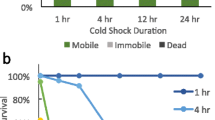Abstract
Survival data from Caenorhabditis elegans strain TJ1060 (spe-9; fer-15) following brief exposure to 35 °C have been investigated. Three experiments with 3-day-old worms were conducted with heat duration ranging between 0 and 12 hours. A statistically significant increase in life expectancy was observed in the groups heated for less than 2 hours, as compared to the unheated control groups. In different experiments P-values for the observed life spans under the hypothesis that heating has no influence on longevity were P < 0.004 after 0.5 hour heat, P < 0.012 after 1 hour heat and P < 0.055 after 2 hours of heating. A biphasic survival model with Gamma distributed frailty has been constructed to describe the survival of worms after heating. The increase in the remaining life expectancy is determined by more effective protection by heat-induced substances in the ages yanger than 27 days. The unheated control group demonstrated acquired heterogeneity of frailty with chronological age while the heat-induced substances defend the worms in a universal way and protect against the development of frailty.
Similar content being viewed by others
References
Brooks A, Lithgow GJ and Johnson TE (1994) Mortality rates in genetically heterogeneous population of Caenorhabditis elegans. Science 263: 668-671
Cox DR and Oakes D (1984) Analysis of Survival Data. Chapman & Hall, New York
Dahlgaard J, Loeschke V, Michalak P and Justesen J (1998) Induced thermotolerance and associated expression of the heat-shock protein Hsp70 in adult Drosophila melanogaster. Func Ecol 12: 786-793
Easton DM (1997) Gompertz growth in number dead confirms medflies and nematodes show excess oldster survival. Exp Gerontol 32: 719-726
Gompertz B (1825) On the nature of the function expressive of the law of human mortality, and on a new mode of determining the value of life contingencies. Phil Trans Phil Soc London A 115: 513-585
Jazwinski SM (1998) Genetics of longevity. Exp Gerontol 33: 773-783
Johnson TE (1997) Genetic influences on aging. Exp Gerontol 32: 11-22
Johnson TE and Hartman PS (1988) Radiation effects on life span in Caenorhabditis elegans. J Gerontol A Biol Sci Med Sci 43: B137-B141
Johnson TE, Lithgow GJ and Murakami S (1996) Hypothesis: Interventions that increase the response to stress offer the potential for effective life prolongation and increased health. J Gerontol A Biol Sci Med Sci 51A: B392-B395
Kalbfleisch JD and Prentice RL (1980) The Statistical Analysis of Failure Time Data. Wiley, New York
Klass MR (1977) Aging in the nematode Caenorhabditis elegans: Major biological and environmental factors influencing life span. Mech Ageing Dev 6: 413-429
Larsen PL (1993) Aging and resistance to oxidative damage in Caenorhabditis elegans. Proc Natl Acad Sci USA 90: 8905-8909
Le Bourg E and Minois N (1999) A mild stress, hypergravity exposure, postpones behavioral aging in Drosophila melanogaster. Exp Gerontol 34: 157-172
Lithgow GJ, White TM, Melov S and Johnson TE (1995) Thermotolerance and extended life-span conferred by single-gene mutations and induced by thermal stress. Proc Natl Acad Sci USA 92: 7540-7544
Masoro EJ (1998) Hormesis and the antiaging action of dietary restriction. Exp Gerontol 33: 61-66
Martin GM, Austad SN and Johnson TE (1996) Genetic analysis of ageing: Role of oxidative damage and environmental stress. Nat Genet 13: 25-34
Murakami S and Johnson TE (1996) A genetic pathway conferring life extension and resistance to UV stress in Caenorhabditis elegans. Genetics 143: 1207-1218
Murakami S and Johnson TE (1998) Life extension and stress resistance in Caenorhabditis elegansmodulated by the tkr-1gene. Curr Biol 8: 1091-1094
Sohal RS and Allen RG (1984) Relationship between metabolic rate, free radicals, differentiation, and aging: A unified theory. In: Woodland AD, Blackett AD and Hollaender A (eds) Molecular Biology of Aging, pp 75-104. Plenum Press, New York
Strehler BL and Mildvan AS (1960) General theory of mortality and aging. Science 132: 14-21
Tatar M (1999) Transgens in the analysis of life span and fitness. Am Nat 154: S67-S81
Vanfleteren JR (1993) Oxidative stress and ageing in Caenorhabditis elegans. Biochem J 292: 605-608
Vanfleteren JR, De Vreese A and Braeckman BP (1998) Twoparameter logistic and Weibull equations provide better fits to survival data from isogenic populations of Caenorhabditis elegansin axenic culture than does the Gompertz model. J Gerontol A Biol Sci Med Sci 53A: B393-B403
Vaupel JW, Manton KG and Stallard E (1979) The impact of heterogeneity in individual frailty on the dynamics of mortality. Demography 16: 439-454
Vaupel JW, Johnson TE and Lithgow GJ (1994) Rates of mortality in population of Caenorhabditis elegans(technical comments). Science 266: 826-828
Walker GA, Walker DW and Lithgow GJ (1998) A relationship between thermotolerance and longevity in Caenorhabditis elegans. J Invest Dermatol Symp Proc 3: 6-10
Wilson DL (1994) The analysis survival (mortality) data: fitting Gompertz, Weibull, and logistic functions. Mech Ageing Dev 74: 15-33
Author information
Authors and Affiliations
Corresponding author
Rights and permissions
About this article
Cite this article
Michalski, A.I., Johnson, T.E., Cypser, J.R. et al. Heating stress patterns in Caenorhabditis elegans longevity and survivorship. Biogerontology 2, 35–44 (2001). https://doi.org/10.1023/A:1010091315368
Issue Date:
DOI: https://doi.org/10.1023/A:1010091315368




